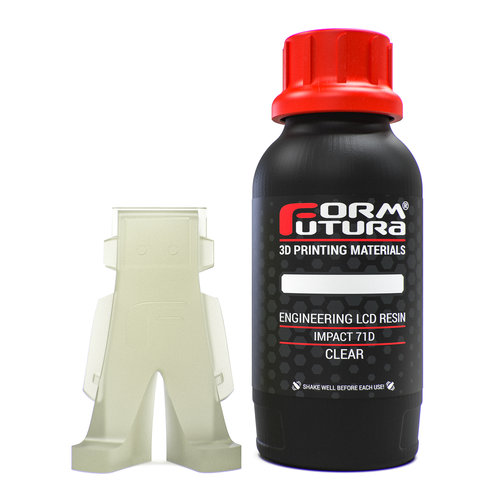FormFutura
Impact 71D Resin "Engineering LCD Series", transparent - 500 ml
€57,50
Impact 71D LCD resin is rock hard and stiff. This resin is like ABS, but with improved impact resistance and 71 ShoreD hardness. It is suitable for all open-source SLA, DLP, LCD/MSLA printers between 385 – 405nm.
Availability:
In stock
Impact 71D LCD resin is an ABS-like hard and stiff resin for universal use with 71 ShoreD hardness
This engineering LCD resin can be used for all types of open-source resin 3D printers (SLA, DLP and LCD/MSLA) within the range of 385 – 405 nanometers.
Due to the combination of strength and rigidity, Impact 71D Resin is used for functional applications such as prototypes, tools, click closures, mechanical and functional parts, electrical housings and even as short term productions. This resin has an enhanced impact resistance.
Impact 71D is excellent to machine and you can easily screw into it. This resin is also excellent for post-processing.
*NB: Pay close attention when using resins and read the safety instructions here
> Safety data sheet Impact 71D Resin
Features Impact 71D Resin:
- Strong and rigid like ABS
- Improved impact resistance
- Excellent machinabillity
- Suitable for all types of open source Resin 3D printers
Commissioning:
- Resins consist of chemicals: When using resins, therefore, always wear protection and protective aids such as nitrin gloves, safety glasses and a mouth mask against gases and vapors type FFP2 or type A.
- Avoid contact with skin, eyes and inhalation of toxic fumes; therefore wear a suitable face mask > read the safety regulations for the use of resin carefully.
- Shake the bottle for at least 2 minutes
- Then let the bottle rest for 10 minutes to get the air bubbles away
Post-processing:
- We advise you to post-treat the 3D print to obtain the correct material properties
- Rinse your 3D print for 5 minutes in a bath of IPA or BioEthanol in an ultrasonic cleaner
- Make sure your print is completely dry for further post-processing
- The 3D print must dry for at least 30 minutes in a well-ventilated area
- Place the resin 3D print in a curing unit to cure under the influence of a UV source for about 20-30 minutes at 65°C
- A wavelength of 300-410 nanometers is preferred
Work order post-processing:
- Remove the print
- Clean the print with IPA or BioEthanol
- Let the print dry well
- Remove the support
- Cure the print in a curing chamber under a certain temperature and UV light
- Optional finishing (sanding, polishing, priming and painting)

No reviews found...





















